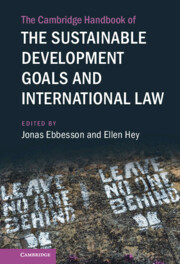19 results
Preface
-
- Book:
- The Cambridge Handbook of the Sustainable Development Goals and International Law
- Published online:
- 23 September 2022
- Print publication:
- 08 September 2022, pp xiii-xiv
-
- Chapter
- Export citation
Index
-
- Book:
- The Cambridge Handbook of the Sustainable Development Goals and International Law
- Published online:
- 23 September 2022
- Print publication:
- 08 September 2022, pp 443-470
-
- Chapter
- Export citation
Introduction: The Sustainable Development Goals, Agenda 2030, and International Law
-
-
- Book:
- The Cambridge Handbook of the Sustainable Development Goals and International Law
- Published online:
- 23 September 2022
- Print publication:
- 08 September 2022, pp 1-49
-
- Chapter
- Export citation

The Cambridge Handbook of the Sustainable Development Goals and International Law
-
- Published online:
- 23 September 2022
- Print publication:
- 08 September 2022
Abbreviations
-
- Book:
- The Cambridge Handbook of the Sustainable Development Goals and International Law
- Published online:
- 23 September 2022
- Print publication:
- 08 September 2022, pp xv-xx
-
- Chapter
- Export citation
Contributors
-
- Book:
- The Cambridge Handbook of the Sustainable Development Goals and International Law
- Published online:
- 23 September 2022
- Print publication:
- 08 September 2022, pp ix-xii
-
- Chapter
- Export citation
Contents
-
- Book:
- The Cambridge Handbook of the Sustainable Development Goals and International Law
- Published online:
- 23 September 2022
- Print publication:
- 08 September 2022, pp v-viii
-
- Chapter
- Export citation
Copyright page
-
- Book:
- The Cambridge Handbook of the Sustainable Development Goals and International Law
- Published online:
- 23 September 2022
- Print publication:
- 08 September 2022, pp iv-iv
-
- Chapter
- Export citation
3 - Global or European Only? International Law on Transparency in Environmental Matters for Members of the Public
- from Part I - International Environmental Law
-
-
- Book:
- Transparency in International Law
- Published online:
- 05 December 2013
- Print publication:
- 07 November 2013, pp 49-74
-
- Chapter
- Export citation
Contributors
-
-
- Book:
- Transparency in International Law
- Published online:
- 05 December 2013
- Print publication:
- 07 November 2013, pp x-xii
-
- Chapter
- Export citation
Preface and acknowledgments
-
-
- Book:
- Environmental Law and Justice in Context
- Published online:
- 28 June 2009
- Print publication:
- 19 February 2009, pp xi-xii
-
- Chapter
- Export citation
1 - Introduction: dimensions of justice in environmental law
-
-
- Book:
- Environmental Law and Justice in Context
- Published online:
- 28 June 2009
- Print publication:
- 19 February 2009, pp 1-36
-
- Chapter
- Export citation
List of contributors
-
- Book:
- Environmental Law and Justice in Context
- Published online:
- 28 June 2009
- Print publication:
- 19 February 2009, pp viii-x
-
- Chapter
- Export citation
14 - Piercing the state veil in pursuit of environmental justice
- from Part III - State sovereignty and state borders
-
-
- Book:
- Environmental Law and Justice in Context
- Published online:
- 28 June 2009
- Print publication:
- 19 February 2009, pp 270-294
-
- Chapter
- Export citation
Index
-
- Book:
- Environmental Law and Justice in Context
- Published online:
- 28 June 2009
- Print publication:
- 19 February 2009, pp 462-483
-
- Chapter
- Export citation
Contents
-
- Book:
- Environmental Law and Justice in Context
- Published online:
- 28 June 2009
- Print publication:
- 19 February 2009, pp v-vii
-
- Chapter
- Export citation
Frontmatter
-
- Book:
- Environmental Law and Justice in Context
- Published online:
- 28 June 2009
- Print publication:
- 19 February 2009, pp i-iv
-
- Chapter
- Export citation

Environmental Law and Justice in Context
-
- Published online:
- 28 June 2009
- Print publication:
- 19 February 2009
8 - Transboundary corporate responsibility in environmental matters: fragments and foundations for a future framework
-
-
- Book:
- Multilevel Governance of Global Environmental Change
- Published online:
- 04 May 2010
- Print publication:
- 17 March 2006, pp 200-224
-
- Chapter
- Export citation



